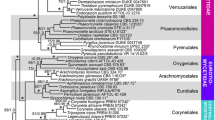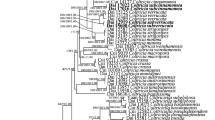Abstract
An unusual species of Geastrum was found growing on decayed wood debris and leaves of Triplochiton scleroxylon in the Mbalmayo Forest Reserve, Cameroon. The species morphologically resembles G. saccatum and G. fimbriatum in having sessile endosperidium partly enclosed by the saccate base of the exoperidium. Microscopically, it is characterized by and distinguished from all other known species of the genus, in having subsmooth, punctate to moderately verruculose, slightly thick-to distinctly thick-walled polymorphous, constricted to eight-shaped, mostly oblong, ovoid, cylindrical, elliptic to clubshaped basidiospores. G. pleosporus was studied from a collection of about fifteen basidiomata covering different stages of development. It is described as new based on morphological analyses and phylogenetic inferences made from large ribosomal DNA sequence alignments. Phylogenetic relationship of G. pleosporus is investigated. In parsimony analyses of partial sequences of the large subunit rDNA from selected Gasteromycetes species, G. pleosporus is closely related to G. saccatum within the strongly supported clade of Geastrum species. The cluster of G. pleosporus and G. saccatum is well supported in parsimony analysis of the dataset with Geastrum species and related taxa using parsimony and maximum likelihood analysis.
Similar content being viewed by others
References
Baseia IG, Milanez AI (2002) Geastrum setiferum (Gasteromycetes): A new species with a setose endoperidium. — Mycotaxon 84: 135–139.
Calonge FD (1998) Gasteromycetes. I. Lycoperdales, Nidulariales, Phallales, Sclerodermatales, Tulostomatales. — Flora Mycologica Iberica 3: 1–271.
Calonge FD, Daniëls PP (1998) Fungi of the Dja Biosphere Reserve (Cameroon). Notes on some Gasteromycetes. — Boletín de la Sociedad Micológica de Madrid 23: 135–138.
Calonge FD, Demoulin V (1975) Les Gasteromycètes d’Espagne. — Bulletin de la Société Mycologique de France 91: 247–292.
Calonge FD, Moreno-Arroyo B, Gómez J (2000) Aportación al conocimiento de los Gasteromycetes, Basidiomycotina, de Bolivia (América del Sur). Geastrum ovalisporum sp. nov. — Boletín de la Sociedad Micológica de Madrid 25: 271–276.
Cunningham GH (1979) The Gasteromycetes of Australia and New Zealand. — Bibliotheca Mycologica 67: 1–227.
Demoulin V, Dring DM (1975) Gasteromycetes of Kivu (Zaïre), Rwanda and Burundi. — Bulletin Jardin Botanique National de Belgique 45: 339–372.
Dissing H, Lange M (1962) Gasteromycetes of Congo. — Bulletin Jardin Botanique de l’Etat, Bruxelles 32: 325–416.
Dring DM (1964) Gasteromycetes of West Tropical Africa. — Mycological Papers 98: 1–60.
Edwards K, Johnstone C, Thompson C (1991) A simple and rapid method for the preparation of plant genomic DNA for PCR analysis. — Nucleic Acids Research 19: 1349.
Felsenstein J (1985) Confidence limits on phylogenies: an approach using the bootstrap. — Evolution 39: 783–791.
Greuter W, Barrier FR, Burdet H-M, Demoulin V, Filguerias TS, McNeill J, Nicolson DH, Silva PC, Skog JE, Trehane P, Turland NJ, Hawksworth DL, eds. (2000) International Code of Botanical Nomenclature. (St. Louis Code). — Regnum Vegetabile 137. Koeltz Scientific Books, Königstein.
Henrion B, Le Tacon F, Martin F (1992) Rapid identification of genetic variation of ectomycorrhizal fungi by amplification of ribosomal RNA genes. — New Phytologist 122: 289–298.
Hibbett DS, Pine EM, Langer E, Langer G, Donoghue M.J (1997) Evolution of gilled mushrooms and puffballs inferred from ribosomal DNA sequences. — Proceedings of National Academy of Science USA, 94: 12002–12006.
Hills DM, Bull JJ (1993) An empirical test of bootstrapping as a method for assessing confidence in phylogenetic analysis. — Systematic Biology 42: 182–192.
Hjortstam R, Ryvarden L, Watling R (1993) Preliminary checklist of non-Agaricoid Macromycetes in the Korup National Park, Cameroon and surrounding area. — Edinburgh Journal of Botany 50: 105–119.
Holmgren PK, Holmgren NH, Barnett LC (1990) Index Herbariorum. Part I. The Herbaria of the World 8th edition. Regnum Vegetabile vol. 120. New York Botanical Garden.
Humpert AJ, Giachini AJ, Muench EL, Gastellano MA, Spatafora JW (2001) Molecular phylogenetics of Ramaria and related genera: evidence from nuclear large subunit and mitochondrial small subunit rDNA sequences. — Mycologia 93: 465–477.
Kimura M (1980) A simple method for estimating evolutionary rates of base substitutions through comparative studies of nucleotide sequences. — Journal Molecular Evolution 16: 111–120.
Kornerup A, Wanscher JH (1978) Taschenlexikon der Farben, 1400 Farbnuancen und 600 Farbnamen. Zürich-Göttingen. 242 pp.
Krüger D, Binder M, Fischer M, Kreisel H (2001) The Lycoperdales. A molecular approach to the systematics of some gasteroid mushroom. — Mycologia 93: 947–957.
Mullis KB, Faloona FA (1987) Specific synthesis of DNA in vitro via a polymerase-catalyzed chain reaction. — Methods Enzymologic 155: 335–350.
O’Donnell K (1993) Fusarium and its near relatives. In Reynolds DR, Taylor JW (eds) The fungal holomorph: mitotic, meiotic and pleomorph speciation in fungal systematic, pp 225–233. CAB International, Wallingford.
Persoon CH (1801) Synopsis Methodica Fungorum, 706 p.
Ponce De León P (1968) A revision of the family Geastraceae. — Fieldiana Botany 31: 302–349.
Pouzar Z (1971) Geastrum sessile (Sow.) Pouzar, the correct name for Geastrum fimbriatum Fr. (Gasteromycetes). — Folia Geobotanica et Phytotaxonomica Bohemoslovaca. 6: 93–97.
Rambaut A (2002) Sequence Alignment Editor. Version 2.0. Department of Zoology, University of Oxford, South Parks Road, Oxford OXI 4JD, U.K.
Soto MK, Wright JE (2000) Taxonomía del género Geastrum (Basidiomycetes, Lycoperdales) en la provincia de Buenos Aires, Argentina. — Boletín de la Sociedad Argentina de Botánica 34: 185–201.
Sunhede S (1989) Geastraceae (Basidiomycotina). Morphology, ecology and systematic, with special emphasis on the North European species. Synopsis Fungorum 1. Fungiflora. Oslo.
Swofford DL (2002) PAUP: Phylogenetic Analysis Using Parsimony, version 4.b10. Illinois Natural History Survey: Champion, Illinois.
White TJ, Bruns T, Lee S, Taylor J (1990) Amplification and direct sequencing of fungal ribosomal RNA genes for phylogenetics. In PCR protocols: a guide to methods and applications. Edited by M.A. Innis, H. Gelfand, J.S. Sninsky, and T.J. White. Academic Press, New York, pp. 315–322.
Author information
Authors and Affiliations
Corresponding author
Rights and permissions
About this article
Cite this article
Douanla-Meli, C., Langer, E. & Calonge, F.D. Geastrum pleosporus sp. nov., a new species of Geastraceae identified by morphological and molecular phylogenetic data. Mycol Progress 4, 239–250 (2005). https://doi.org/10.1007/s11557-006-0127-3
Accepted:
Issue Date:
DOI: https://doi.org/10.1007/s11557-006-0127-3




